#schloss ludwigslust
Explore tagged Tumblr posts
Text
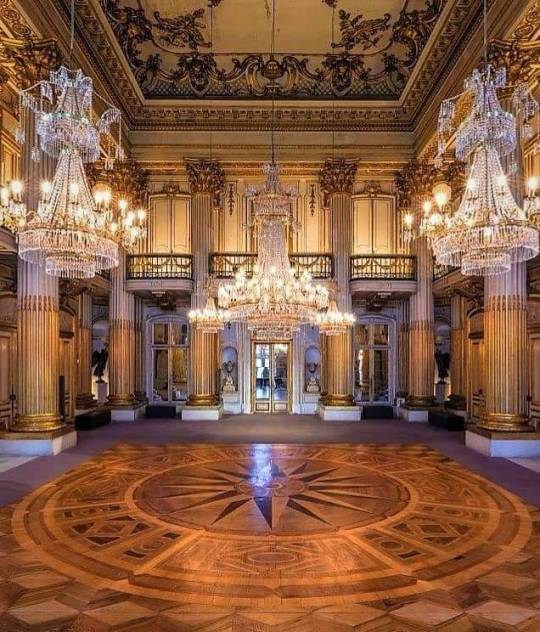
The Golden Hall at Schloss Ludwigslust, western Pomerania, GERMANY
#the golden hall#schloss ludwigslust#ludwigslust castle#ludwigslust#western#pomerania#germany#alemania#europe#europa
19 notes
·
View notes
Photo
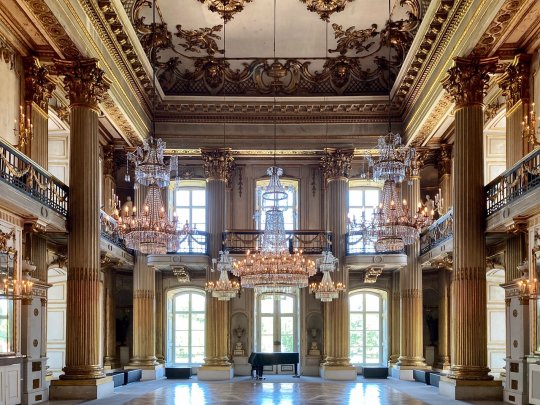
Schloss Ludwigslust, Ludwigslust, Mecklenburg-Vorpommern, Germany
#art#design#interiors#architecture#ballroom#schloss#schloss ludwigslust#ludwigslust#germany#mecklenburg-vorpommern#luxury house#luxury home#luxury lifestyle#history#style
252 notes
·
View notes
Photo
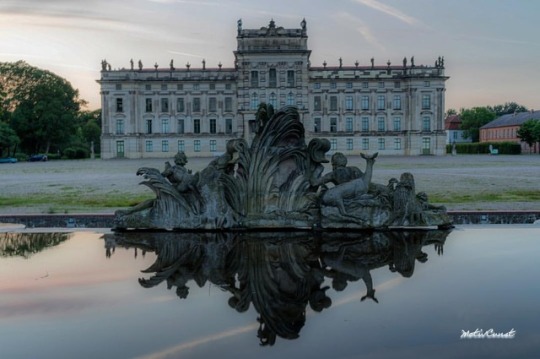
||Schloss Ludwigslust|| #ludwigslust #schlossludwigslust #mvtutgut #ludwigslusterschloss #brunnen #skulptur #reflection #reflektion #reflections #schlosspark #schloss #motivcunst #bluesky #evening #abendstimmung #heidekreisfotografie #fotografie #photography #sonyalpha #sonyphotography #sonya7ii (hier: Ludwigslust, Germany) https://www.instagram.com/p/BvPanNin3C0/?utm_source=ig_tumblr_share&igshid=1kwb5l7z9cg76
#ludwigslust#schlossludwigslust#mvtutgut#ludwigslusterschloss#brunnen#skulptur#reflection#reflektion#reflections#schlosspark#schloss#motivcunst#bluesky#evening#abendstimmung#heidekreisfotografie#fotografie#photography#sonyalpha#sonyphotography#sonya7ii
16 notes
·
View notes
Photo

Der neu gestaltete Bereich am Bassin vor dem Schloss Ludwigslust #ludwigslust #luftbild #aerialphotography #dronephotography #dronestagram #mecklenburg #schloss #mavicpro #djimavicpro #mecklenburgvorpommern #germany (hier: Ludwigslust, Germany)
#schloss#dronestagram#mecklenburg#germany#mecklenburgvorpommern#ludwigslust#djimavicpro#dronephotography#aerialphotography#mavicpro#luftbild
14 notes
·
View notes
Photo

"Ich brauche kein Zuhaus und ich Brauch kein Geld. Unser Schloss ist die ganze Welt, unsere Decke ist das Himmelszelt." (Santiano) Gerechtigkeit heißt wenig haben. Alle teilen gemeinsam ihre Gaben. Es gibt viele die uns betrügen. Sie wollen mehr und sie lügen. Um mehr zu bekommen, Kapital. Dieses "haben wollen" ist banal. Denn oft finden sie kein Glück und das Schicksal fordert zurück. Das Leben was geliehen war. So war man im Leben eine Gefahr Für Gesellschaft und Gemeinde. Dachte man hätte wenig Feinde. So verschenke ich Schlafsäcke Damit hoffentlich keiner verrecke. Ich lade auf mein Schiff ein. So ist niemand hilflos und allein. Habe den Mut einfach mitzumachen. Auch wenn diverse Ide.... lachen. Hisse die Flagge für Menschlichkeit. Dort wo du bist ist viel zu viel Leid. (Sammy) #grabow #Ludwigslust #qualitätszeit #schloss #Mecklenburg #bestertag #segeln #schlei #sh #jesus https://www.instagram.com/p/B66sNaTIBhj/?igshid=1qg1qi092evq8
0 notes
Photo
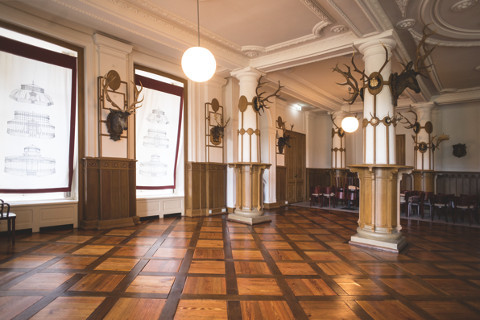


www.irsa.de
REFERENZEN - IRSA Das barocke Schloss Ludwigslust -
der 200 m2 grosse Boden im Jagdsalon wurde nicht aus Pappmache gefertigt, sondern nach aufwändigen Renovierarbeiten mit IRSA HP Oil geschützt
Prächtig liegt das Schloss in der gleichnamigen Stadt im südwestlichen Mecklenburg-Vorpommern. Herzog Friedrich liess in den Jahren 1772 bis 1776 das neue Residenzschloss erbauen. Eine derartige Anlage mit Schloss und weitläufiger Gartenarchitektur gibt es kein zweites Mal im nordelbischen Raum. Nahezu 17 Millionen Euro sind bereits in die Restaurierung geflossen. Ein Kuriosum der Ludwigsluster Schlossanlage ist die nahezu durchgehende Verwendung von Pappmaché als Werkstoff zur Imitation hochwertiger, kostenintensiver Materialien.
0 notes
Photo
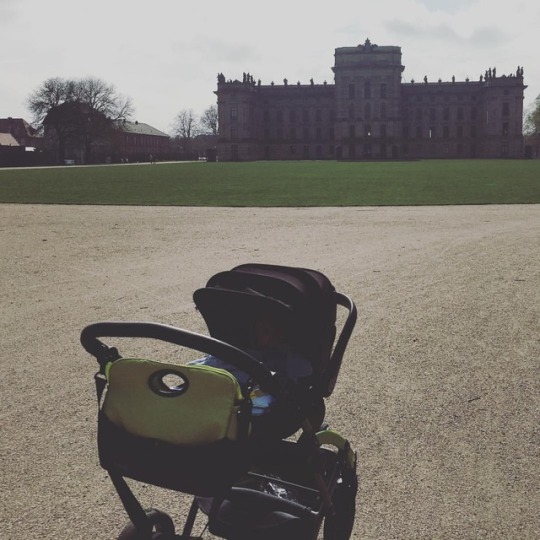
#ich in #ludwigslust #urlaub mit Mama und Papa #schloss
2 notes
·
View notes
Text
Day 51, 10th Oct, Lubeck
I think it ended up being a good move not going to Wismar yesterday as the weather was a lot better today. I bought a day ticket for the train which you can have up to 5 people on if in travel within the state on regional trains. Even being on my own it worked out much cheaper than individual tickets to where I was going. My hotel was across the road from the train station so I just left my bags there after checking out. Wismar was about 25 mins on the train from Schwerin.
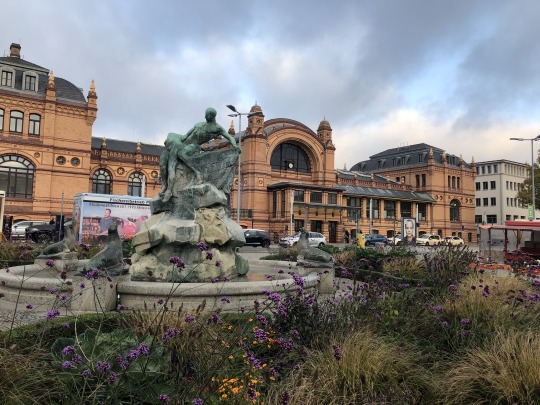
Wismar has been given World Heritage listing due to the fact that it has the largest preserved ancient town centre in the Baltic regional and is a memorial to medieval building techniques and lifestyle.
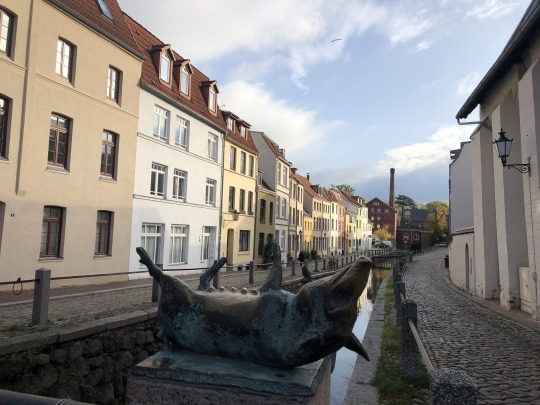
I loved these bottomless chairs being used for pots. Maybe something I could do on my new balcony.
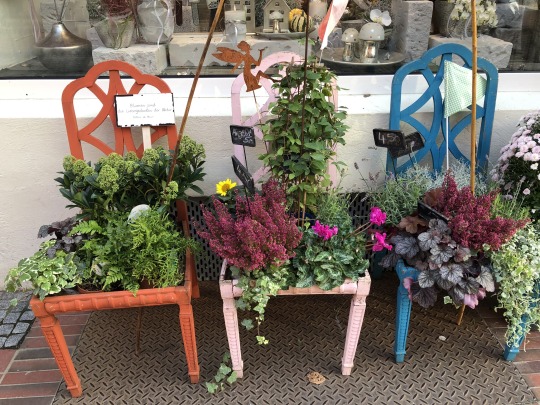
Many of the buildings throughout the town are original and show the wealth that came to Wismar from its importance in medieval times.
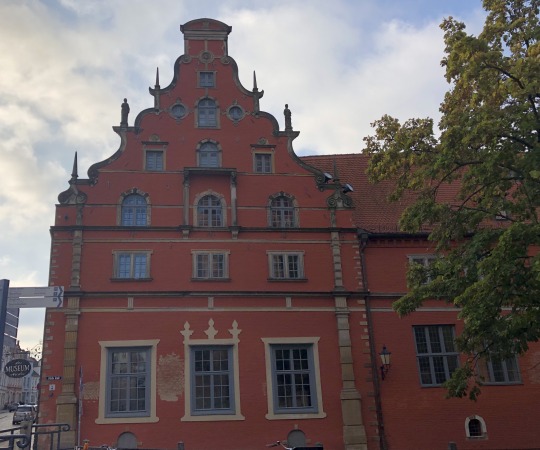
The 80m high tower of the Church of St Mary is a landmark of Wismar. The church was damaged in WWII and then demolished in 1960. Up until that time it was reputed to be one of the most beautiful brick churches in Northern Germany.
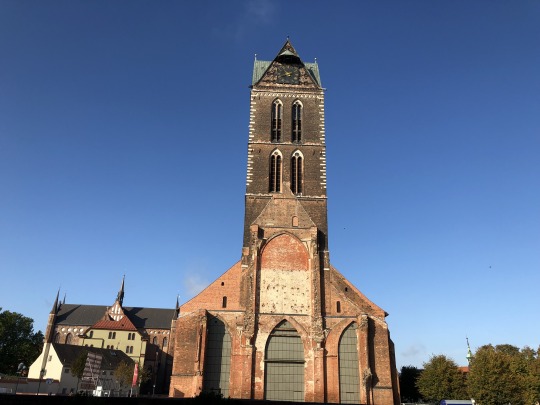
An old water wheel in the grounds of the church.
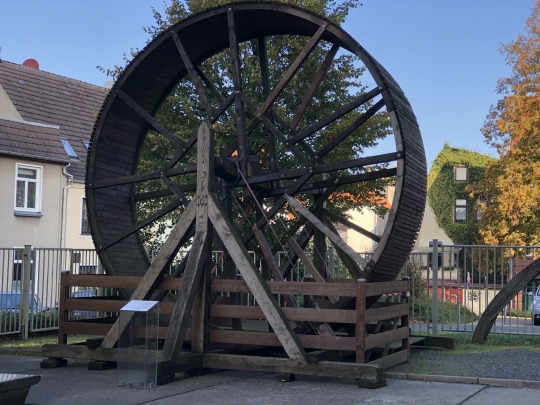
This pumping station in the market square was constructed between 1580 and 1602 following plans drawn up in the style of the Dutch Renaissance. It supplied the town with drinking water until 1897.
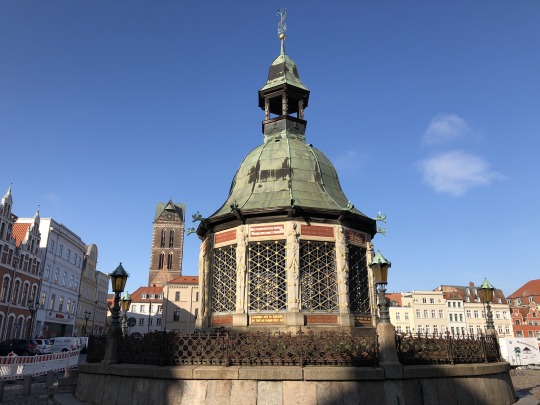
Around the Market Square were many attractive buildings.
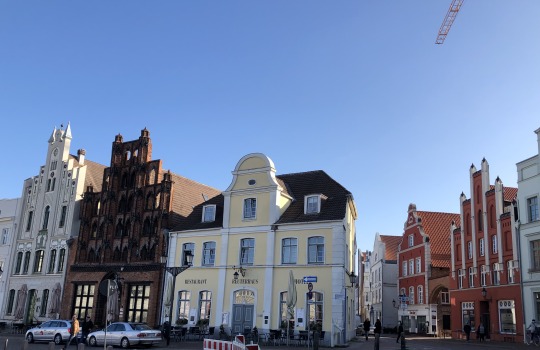
The brick building is known as the Alter Schwede, the Old Swede, and was built around 1830. In the Middle Ages there were residential and business premises on the ground floor and the first floor was used for stoarage. The building’s name was given in remembrance of Wismar’s Swedish period from 1648 to 1803.
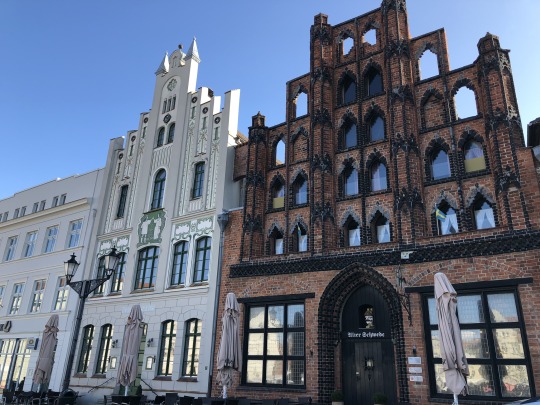
Wismar’s Market Square is one of the largest in Northern Germany. The town hall has been reconstructed in the classical style between 1817 and 1819.
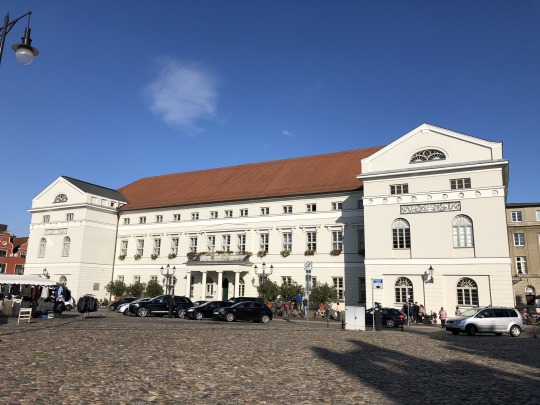
Kramer Strabe has many remarkable gabled houses which indicates its earlier and current role as a business boulevard.
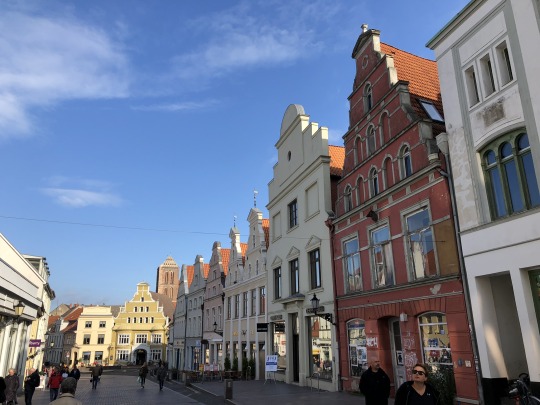
Out buildings surrounding the church complex.
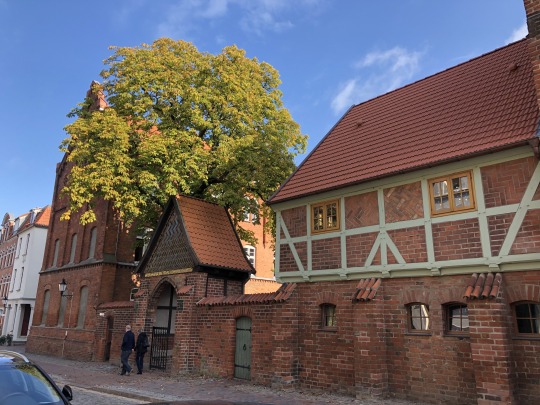
The Church of the Holy Spirit is a rectangular Gothic naveless church which came into being in its present form in the 15th Century. The interior is covered by a painted wooden ceiling.
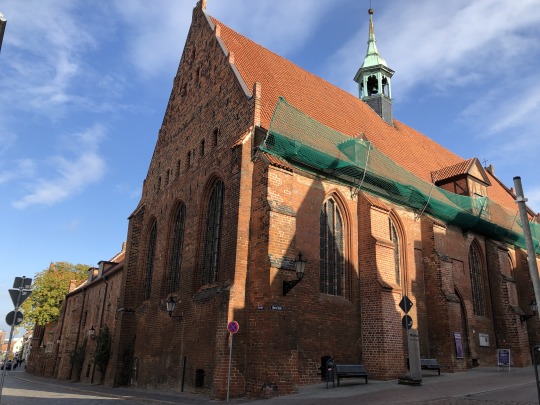
Another lovely street. Wismar has retained, virtually unaltered, the medieval layout to this day.
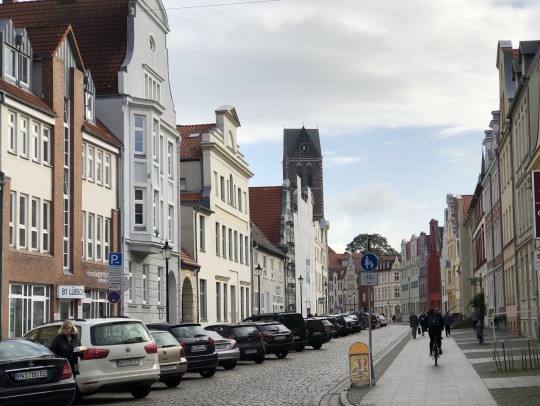
Buildings near the harbour. Much of Wismar’s wealth came from its access to a harbour.
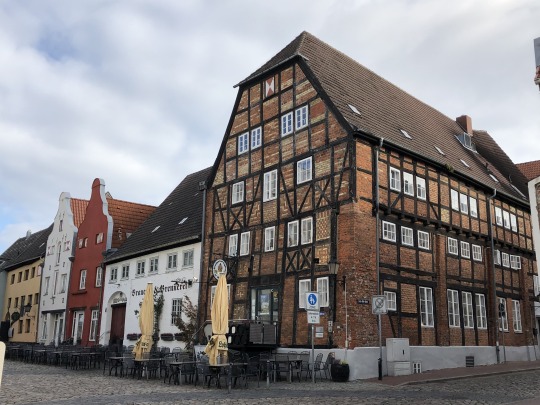
Lovely old building over the canal that runs through the town.
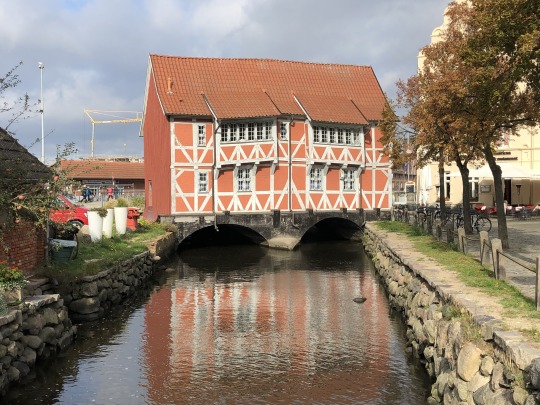
Old harbour.
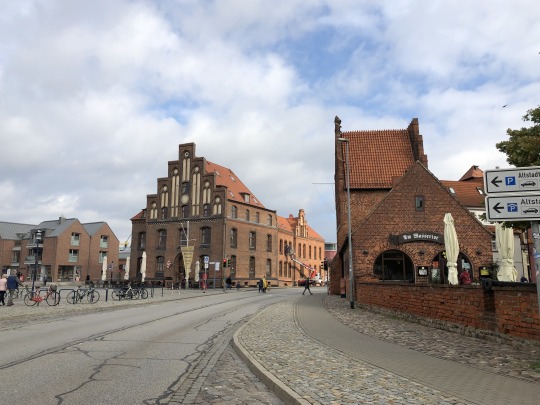
The Water Gate is the last of the five town gates which were incorporated into a 4m high town wall. The gate was erected around 1450 in the late Gothic style.
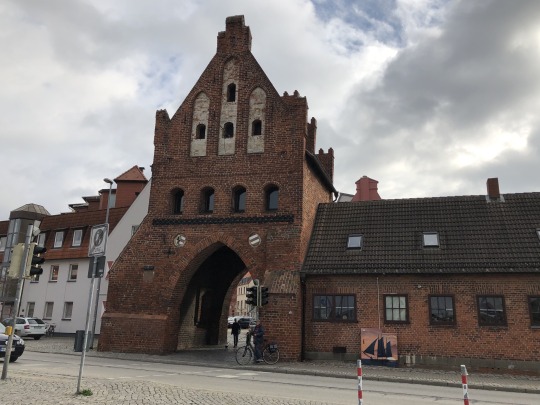
The street that runs from the Water Gate.
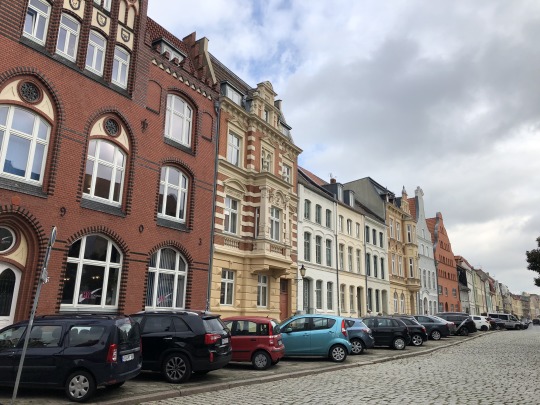
St Nikolai Kirche has a 37m high central nave and is the fourth largest church nave in Germany. Construction of the church began in the 14th Century.
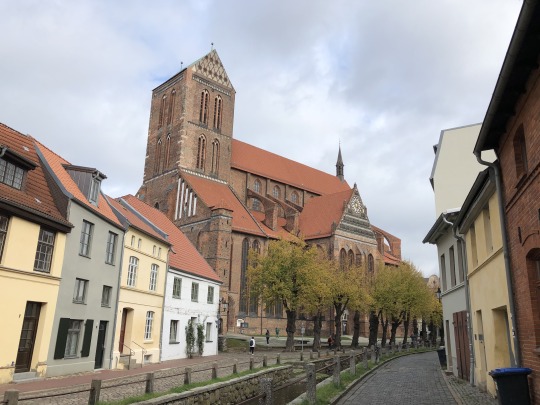
These brick churches are very impressive inside.
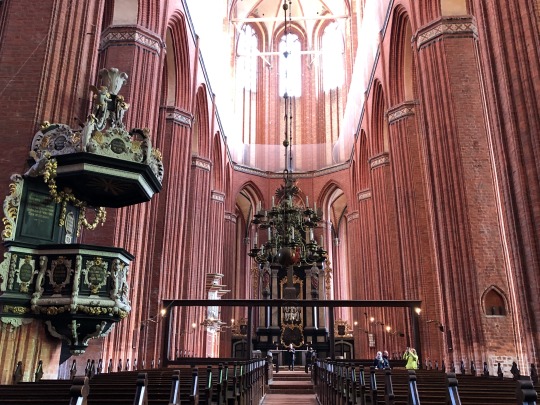
Very high and strong looking.
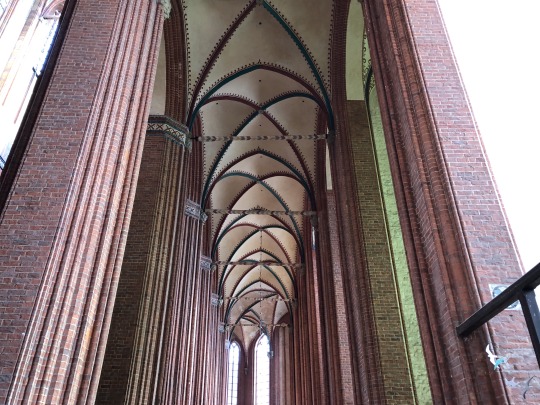
Guided statues of the bible story.
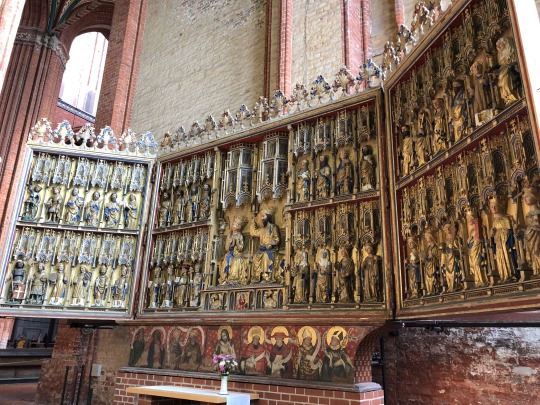
Patterned columns.
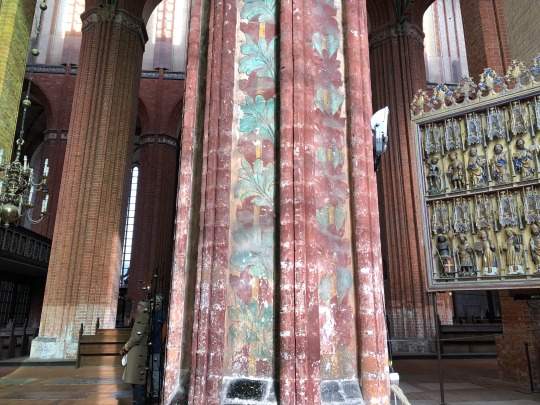
These churches are impressive buildings and to imagine they were built such a long time ago.
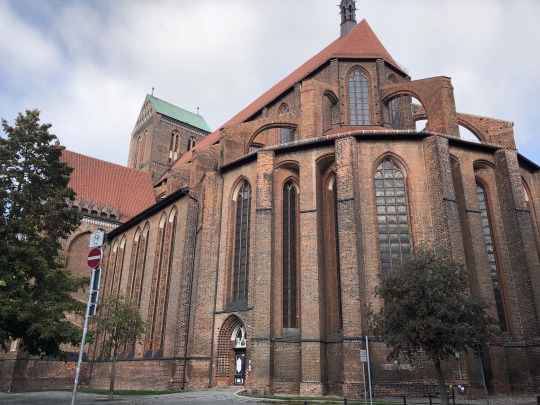
A treey walkway near the church.
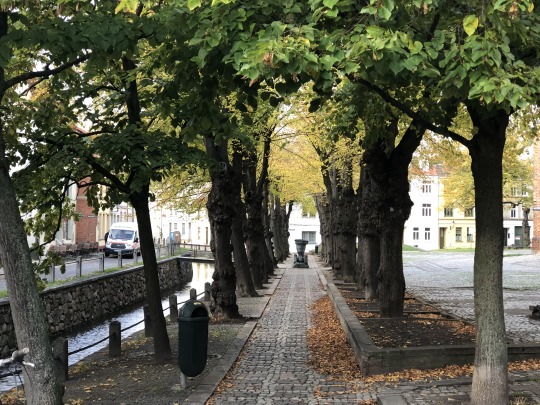
The sun had come out which made everything look brighter.
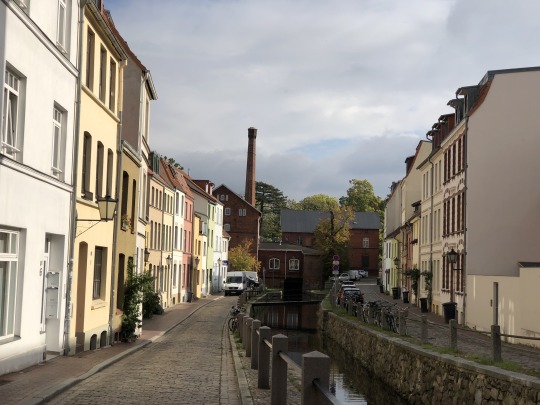
From Wismar I caught the train again and decided to continue on past Schwerin to Ludwigslust. I think the train just runs up and down between these three towns all day. I wanted to go to Ludwigslust as there was a substantially Schloss there. It was about a 20 minute walk from the train station to the Schloss.
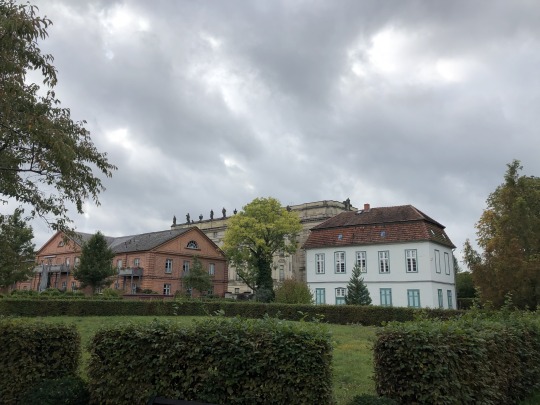
The Schloss from the garden side. The Schloss was originally built as a hunting lodge, rebuilt as a luxurious retreat from the ducal capital of Schwerin, then became for a time the centre of government in 1765-1837. The Schloss was the ‘joy’ of Prince Christian Ludwig, the heir of the Duke of Mecklenburg-Schwerin, hence the name Ludwigslust.
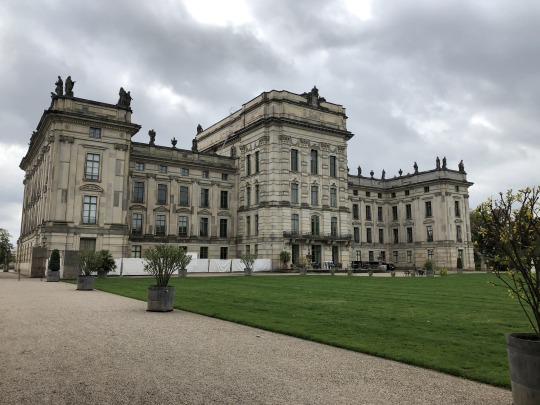
The water cascades from the front of the Schloss with the kirche in the background.
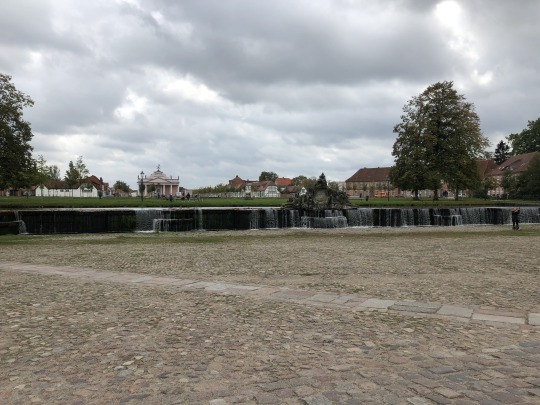
The Schloss kirche
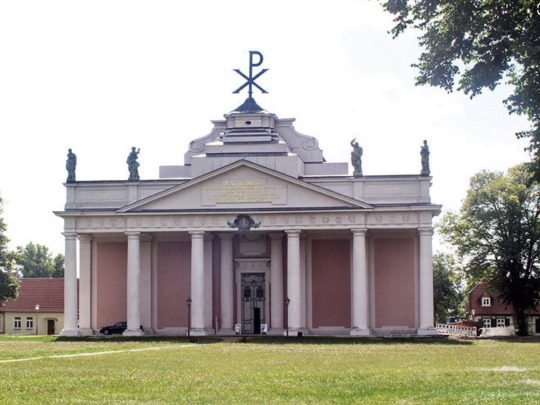
Inside the Schloss kirche
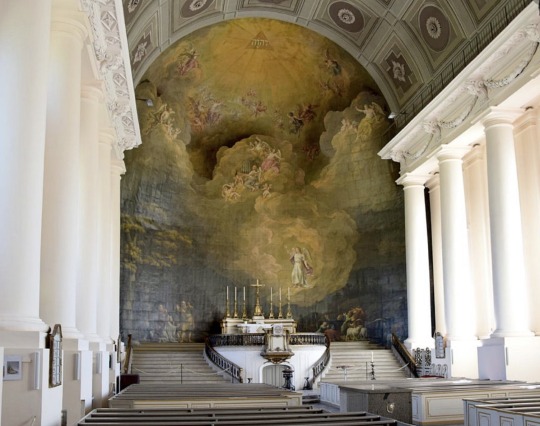
The front of the Schloss
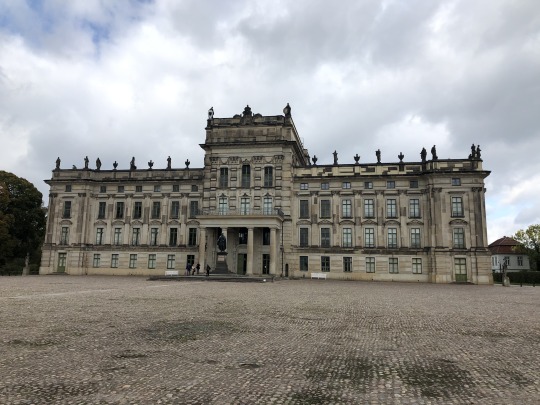
The cafe with a number of prized heads from hunting.
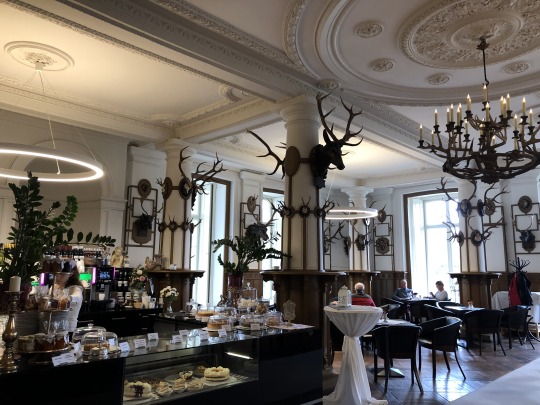
One of the main reception rooms. There were a few large paintings of animals throughout the Schloss.
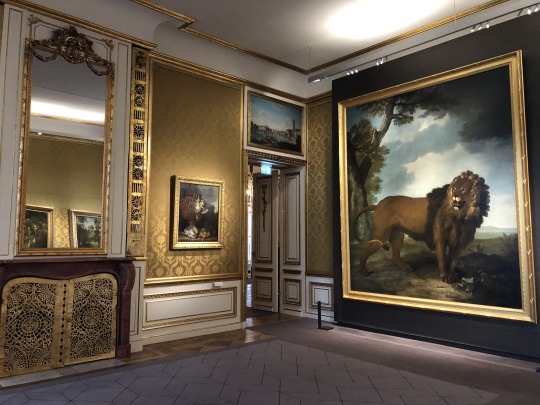
The Throne Room.
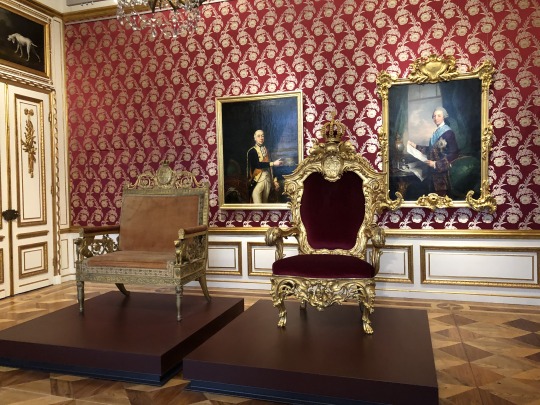
The painting gallery.
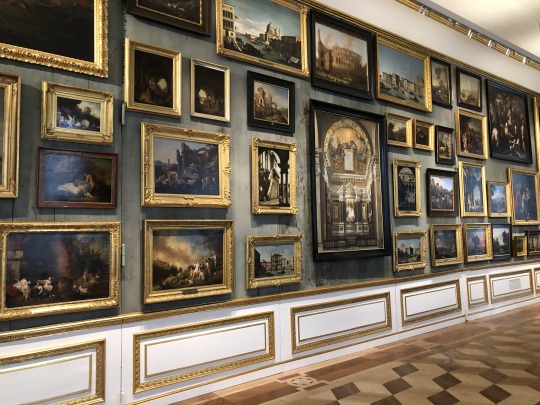
The chandelier, mirror and fireplace were all made of Meissen porcelain. Just exquisite.
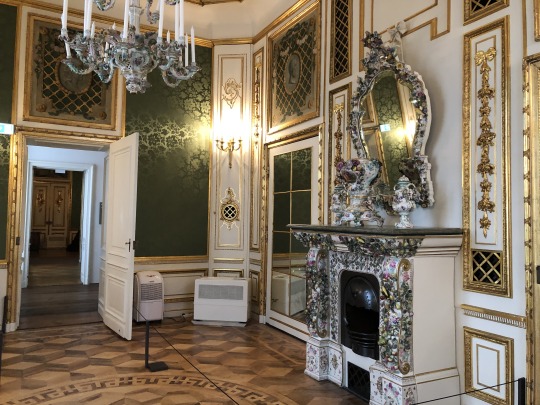
The beautiful chandeliers of the ballroom.
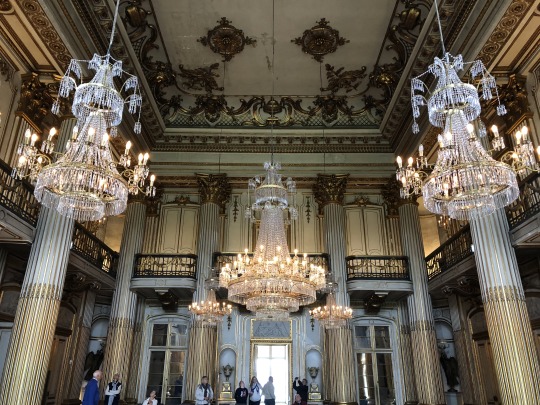
Me reflected in one of the ballroom mirrors.
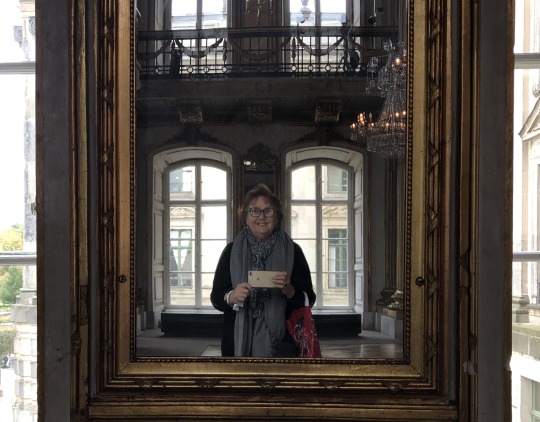
Lots of nice, decorative houses were all through the streets.
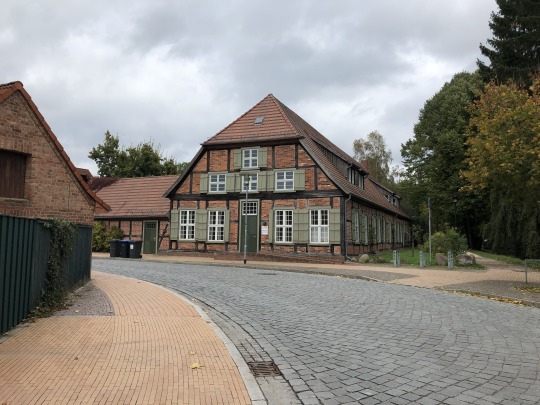
Very solid brick buildings are found in this area.
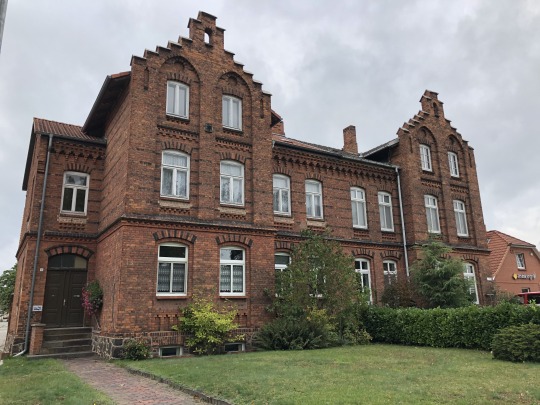
It was lovely walking back through the streets to the train station.
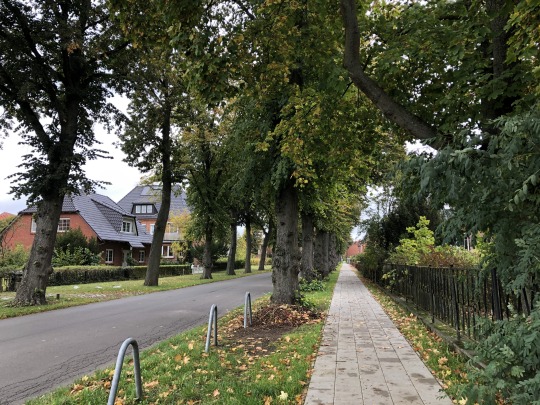
I caught the train back to Schwerin, collected my bags and then caught the train to Lubeck an hour away. I was staying in Lubeck for two nights so it didn’t matter that I got there late afternoon. I had had a very full day but it all worked out well. I got to see everything that I had planned.
6 notes
·
View notes
Text
Ein Besuch in Ludwigslust – Die besten Sehenswürdigkeiten Ludwigslust ist eine kleine Stadt in Mecklenburg-Vorpommern, die viele Sehenswürdigkeiten und Attraktionen zu bieten hat. Es gibt viele historische Gebäude, gut erhaltene Gärten und Parks, die es zu entdecken gilt. Egal, ob Sie ein Wochenende oder länger in Ludwigslust verbringen, Sie werden sicherlich viele interessante Orte finden, die Sie besuchen können. Schloss Ludwigslust Eines der bekanntesten Sehenswürdigkeiten von Ludwigslust ist das Schloss Ludwigslust. Es ist ein prächtiges barockes Schloss, das im 18. Jahrhundert erbaut wurde. Es steht auf einer Anhöhe und bietet einen spektakulären Blick auf die Umgebung. Im Inneren des Schlosses befinden sich eine Vielzahl an Kunstwerken und historischen Gegenständen. Es gibt auch eine beeindruckende Sammlung von Möbeln und anderen Antiquitäten. Ludwigsluster Park Der Ludwigsluster Park ist ein weiterer beliebter Ort in Ludwigslust. Er ist ein großer, gut erhaltener Park, der im 18. Jahrhundert angelegt wurde. Der Park ist ein beliebtes Ausflugsziel für Einheimische und Besucher. Hier können Sie einen Spaziergang machen, die schöne Landschaft bewundern und die vielen Pflanzen und Blumen bewundern. Kloster Dobbertin Das Kloster Dobbertin ist ein weiteres interessantes Ziel in Ludwigslust. Es ist ein ehemaliges Zisterzienserkloster aus dem 12. Jahrhundert. Es wurde im Laufe der Jahrhunderte mehrfach umgebaut, aber einige der ursprünglichen Strukturen sind noch erhalten. Heute ist das Kloster ein beliebtes Ausflugsziel und bietet viele interessante Sehenswürdigkeiten. Stadtmuseum Das Stadtmuseum von Ludwigslust ist eine weitere Sehenswürdigkeit, die Sie besuchen können. Es befindet sich in einem alten Herrenhaus und bietet eine Vielzahl an Exponaten, die die Geschichte der Stadt und der Region erzählen. Hier können Sie viel über die Geschichte von Ludwigslust erfahren und einige interessante Exponate bewundern. Heinrich-Schliemann-Museum Das Heinrich-Schliemann-Museum ist ein weiteres interessantes Museum in Ludwigslust. Es befindet sich in einem alten Herrenhaus und ist der Geburtsort des berühmten Archäologen Heinrich Schliemann. Hier können Sie mehr über sein Leben und seine Arbeit erfahren und einige interessante Exponate bewundern. Gutshaus Boizenburg Gutshaus Boizenburg ist ein weiteres interessantes Sehenswürdigkeit in Ludwigslust. Es ist ein prächtiges Herrenhaus, das im 18. Jahrhundert erbaut wurde. Es beherbergt heute ein Museum, in dem Sie viele interessante Exponate über die Geschichte der Region finden können. Königliche Kapelle Die Königliche Kapelle von Ludwigslust ist ein weiteres interessantes Sehenswürdigkeit in der Stadt. Es ist eine prächtige Kirche, die im 18. Jahrhundert erbaut wurde. Sie ist ein beliebtes Ausflugsziel und bietet viele interessante Exponate über die Geschichte der Region. Fazit Ludwigslust ist eine wunderschöne Stadt in Mecklenburg-Vorpommern, die viele Sehenswürdigkeiten und Attraktionen zu bieten hat. Egal, ob Sie ein Wochenende oder länger in Ludwigslust verbringen, Sie werden sicherlich viele interessante Orte finden, die Sie besuchen können. Von den prächtigen Schloss Ludwigslust und dem Ludwigsluster Park bis hin zu den Museen und Kirchen gibt es viele interessante Sehenswürdigkeiten, die Sie in Ludwigslust besuchen können. Ein Besuch in Ludwigslust lohnt sich auf jeden Fall!
0 notes
Text
prequel: 008
SEPTEMBER 2010 (OSKAR)
Schloss Ludwigslust, Ludwigslust, Mecklenburg
Wednesday, 15 September 2010
His great-grandfather, King Heinrich Ludwig I of Mecklenburg, had shamelessly copied his Dutch cousin (and aunt by her marriage to his half-uncle) and created a national holiday celebrating the birthday of the monarch. The first Königstag, King’s Day, took place on 18 November 1919, only months after the Treaty of Versailles turned the Grand Duchies of Mecklenburg-Schwerin and Mecklenburg-Strelitz into the Kingdom of Mecklenburg. Heinrich Ludwig would appear on the balcony of Schweriner Schloss, wave to the gathered crowds of wellwishers and gawkers, and go back inside where it was nice and warm, leaving his subjects to show their love for their King by throwing street parties and getting drunk in the middle of the day.
King Heinrich Ludwig I died in 1954 and his son carried on the tradition. His great-uncle, Paul Friedrich II of Mecklenburg’s birthday was 10 September and, now, so was Königstag. Thanks to the fairer weather, Paul Friedrich took a more hands on role and began visiting Mecklenburg’s three exclaves in West Germany. Horst, Mannhagen, and Walksfelde were visited each in turn by Paul Friedrich, Queen Thyra, and their children during Paul Friedrich’s long reign.
King Paul Friedrich II died in 1982 and his son carried on the tradition. His father’s first cousin, Wilhelm Franz I of Mecklenburg’s birthday was 17 July, and, now, so was Königstag. Some argued for the date to stay in September as the front half of the calendar year was now overloaded with national holidays, but Wilhelm Franz refused, saying “my birthday’s in July” and that was the end of that. By now, the tradition of visiting the exclaves was well entrenched and much looked forward to by the tiny villages. After Wilhelm Franz married, Eleonora of Leiningen (his mother’s first cousin) joined him, and then their daughter a few years later. When the Soviet Union fell and Mecklenburg regained access to the two exclaves in what was formerly East Germany in 1990, Rossow and Schönberg were added to the rotation. Tragically, Wilhelm Franz would never spend Königstag at Rossow or Schönberg.
King Wilhelm Franz I died in 1992, leaving a three year old queen to carry on the tradition. His second cousin twice over, Karolina Augusta I of Mecklenburg’s birthday was 15 September, and, now, so was Königinnentag. Queen’s Day. Without a husband or any children of her own, Karolina Augusta was joined by her mother and brother during her visits to Mecklenburg’s five exclaves. Karolina Augusta celebrated her first Königinnentag in Mannhagen, and today, celebrated it in Schönberg. Over the decades, the festivities put on by the villages had evolved from small, locally sourced street parties to large, internationally sourced agricultural shows. It was not Lina’s thing. Like, at all. But as with everything else, she threw herself into it each year by letting her hair down (figuratively) and going for a more casual, approachable wardrobe (flat shoes) in order to join in the festivities while still looking wildly out of place standing near livestock and giant vegetables.
Officially, Königinnentag ended when the traditional work day did. Karolina Augusta didn’t hold to traditional work hours, and neither did Oskar.
Oskar Harald Christian Heinrich Philipp af Danmark was born on 19 September 1983 at Euphemiasburg in Bad Doberan, Mecklenburg (because hospitals are for the common folk), the second child but first son of Harald and Helene af Danmark. Although born in Mecklenburg with the intention of being raised in Mecklenburg, Oskar was baptised into the Church of Denmark six months later to appease his grandfather.
As male-line descendants of King Christian IX of Denmark through a succession of approved marriages, Oskar, his older sister Louisa, younger brother Axel, their parents and their aunt were considered members of the Danish Royal Family, and entitled to the rank of Prince or Princess of Denmark and the style of Highness. As male-line descendants of Frederik VIII through his third son, but not his first son, they were, however, excluded from the line of succession. Known to the rest of his paternal family as the Bernstorff branch (named for the palace his grandparents lived in until his grandfather’s death in 1991), they were the appendix of the Danish Royal Family, nice to have around but not essential.
This, rather dry and not entirely interesting, information was relied upon more than Oskar cared to admit. When travelling the country, the continent, or the world, there was nearly always someone who’d crunch up their face and ask why a Danish prince was a representative of the Mecklenburgish queen. He’d like to answer “nepotism?” but instead answered with a variation of “I’m a Mecklenburgish citizen, not a Danish citizen” and avoided getting into explaining Mecklenburg’s standard practice of recognising any foreign rank and style of its citizens so long as the style is not Royal Highness or higher as that’s reserved for very specific people within the Kingdom. If their historical style is Royal Highness or higher they are downgraded, which must ruffle some feathers, but hasn’t stopped Mecklenburg from becoming a kind of refuge for the royally and nobily overthrown.
His business card identified him as Prinz Oskar af Danmark, External European Policy Advisor to The Queen of Mecklenburg. Basically, it was his job to advise his cousin on all things Europe, but not Mecklenburg. Less basically, he got paid to read international news, travel the world, argue with his team about what they should and shouldn’t report back to their boss, and attend so many meetings with people he wanted to strangle half the time. He’d had the job since 2006 after Lina created the role especially for him. Oskar’s detractors argued he was too young, but Lina argued back that there still were plenty of old white men in the Königliches Ministerium für Auswärtige Angelegenheiten und Handel (Royal Ministry of Foreign Affairs and Trade, and abbreviated - as all the ministries were - as KMAAH), and how a fresh perspective was desperately needed.
Despite accepting the job, from the beginning Oskar felt his position was largely unnecessary. A fresh perspective? That was just a nice way of saying “inexperienced”. There were plenty of policy advisors in the KMAAH office. It’s the whole point of the ministry. For months, Oskar dug deep, settled into his fancy office in Schweriner Schloss, poached some employees from the KMAAH office, worked hard to prove his cousin’s faith in him wasn’t misplaced, absorbed as much as he could, soaked up the knowledge of his coworkers, asked question after question after question - except for the question that really mattered, the one keeping him up at night.
“Does my job even matter?”
It took months for Oskar to realise the answer was yes, a resounding, heartfelt yes.
Advising Karolina Augusta on political matters, on Mecklenburg’s role in Europe, the internal politics of her neighbours and how they might affect their homeland was difficult and challenging, but ultimately rewarding. Lina always made sure to show her gratitude. He felt valued, his opinion respected. But working so closely with family, in a world where public and private blurred, required a clear line to be drawn in the sand. Oskar was not her Private Secretary or Deputy Private Secretary. There were areas of her life Lina would not appreciate him putting his two cents in. It was sometimes difficult determining what those areas were. Oskar detested the line in the sand while also understanding the reason behind it. They were cousins, born a handful of years apart with similar outlooks and goals. To jeopardise that relationship because he couldn’t keep his opinions to himself would have been a terrible waste. As strange as it might sound as her family and employee, Oskar was proud to call Lina his friend.
And friends help each other out, even on a national holiday.
Die Papiere were delivered to the monarch of Mecklenburg every day of the year, twice if necessary. The blue leather bound box, secured by a not especially secure lock, would be filled with the previous day’s, or that morning’s, ministerial papers and other matters for the monarch to attend to. On the evening the fifteenth of September, the day’s second batch of die Papiere delivered to Schloss Ludwigslust had a strong foreign flavour to them thanks to the Annual Informal Meeting of German-Speaking Heads of State held the week before in Austria.
During dinner in the Schloss’s Jagdsalon, Hunting Hall, with over twenty of his relatives seated around the vast table between the large room’s deer head and antler decorated pillars, Lina had asked if Oskar could join her in going over the documents should she have any questions. Karolina Augusta I of Mecklenburg always had questions so Oskar said he’d be happy to.
And he was. Let no one doubt his commitment to his job, and queen and country.
After climbing several flights of stairs to the Russische Appartement (the smallest guest apartment consisting of only a bedroom and ensuite) on the second floor to freshen up, Oskar descended the Große Osttreppe to the first floor just after eight.
Two of Lina’s protection officers were on duty on the first floor landing, guarding the doors to Lina’s Appartement, and keeping track of those who used the Große Osttreppe, Wache Halle, and the Goldener Saal (where another pair of Lina’s protection officers guarded another entrance to Lina’s Appartement). The officers nodded their heads at him - he was expected - with one opening the double doors to Lina’s Vorzimmer to alert the Aide-de-Camp on duty that evening.
Oskar waited with the guards while the Aide-de-Camp went to tell Lina of his arrival. His dismal attempt at smalltalk was cut short when Major Lehmann returned with Lina’s permission to wait for her in the Empfangszimmer.
The Major stepped aside to allow Oskar to enter the Vorzimmer ahead of her. Lehmann was Oskar’s favourite of Lina’s three Aides-de-camp. Nowak was very serious, but Stenberg had no sense of humour at all. The Vorzimmer des Monarchen, the Antechamber of the Monarch, was rectangular and primarily yellow in colour due to the wallpaper and upholstery. Originally sparsely decorated to allow the room to hold small groups of people waiting for their turn to see the Dukes and Grand Dukes of yesteryear, the Vorzimmer was now decorated as a drawing room. Sofas and armchairs were arranged in a horseshoe around the fireplace, a couple of end tables, a few buffet tables and cabinets were carefully placed around the room to allow space for paintings (including an enormous painting of a cat-dog faced lion) and an unobstructed view out of the room’s two windows overlooking the grounds behind the Schloss. Atop nearly every flat surface was a vase, overflowing with flowers freshly cut from not only Schloss Ludwigslust’s garden, but from all of Lina’s residences across the country. Amongst the vases were dozens of family photos spanning decades, some stretching back before he or Lina were even born. He was sure he’d find himself in a few photos if he was interested in looking. He wasn’t. He’d seen them all before and didn’t linger as he headed to the open set of double doors to Lina’s Empfangszimmer.
Major Lehmann closed the doors behind him. The Empfangszimmer, Receiving Room, was once the Audienzzimmer, Audience Chamber, as the stately red colour of the wallpaper reminded any visitors aware of the Schloss’s history. Once upon a time, when the court was permanently based in Schloss Ludwigslust, this room was used to receive official guests and hear petitions. The Ducal and Grand Ducal Thrones used by his ancestors were now in Euphemiasburg’s Museum Wing. The Empfangszimmer was now decorated in a similar fashion to the Vorzimmer, though more formally, with fewer flowers and any photographs being of current and former heads of state instead of family members. None of the Vorzimmer’s four sets of double doors were ‘false’, they all leaded somewhere. The same could not be said for the Empfangszimmer’s four sets of double doors. Two were ‘false’ and leaded nowhere revealing only sections of the Schloss’s central heating system. All sets of doors were identically designed to keep the room symmetrical.
The Empfangszimmer had one final door, a ‘hidden’ one. Much smaller in height and disguised to blend into the red wallpaper and white and gold trimmed wooden panelling of the room, this door lead to Lina’s Schlafzimmer, her bedroom. Schloss Ludwigslust had several of these hidden doors, some for staff use, others for the Schloss’s residents and guests, and none of them truly ‘hidden’ if you knew what to look for, or happened to notice the doorknob.
Oskar took a spot in front of the large mirror on the wall between the room’s two windows (most rooms in the Schloss had only one or two windows). The doors connecting the Empfangszimmer and Lina’s Studie was open and Oskar could hear Lina talking to someone. With the only other sound in the room being the soft ticking clock on the mantelpiece, it became impossible not to overhear his cousin in the next room. He tried to distract himself by focusing on the gold framed mirror. Mirror technology was not the best when the Schloss had been built so the two metre tall mirror was actually made up of several pieces. Why hasn’t Lina replaced the small panes with one single piece? Yeah, yeah, they were original to the room -
Yeah, it wasn’t working. He could still hear everything in the next room.
She was on the phone.
“-until November.” Pause. “Maybe. I hope so.” Pause. “Next year. Spring, after Easter, I’d imagine.” Pause. “Well, your summers are terrible so-” Pause. “They are not! We get a lot of sun here.” Pause. “We do not escape to Scotland. No one goes to Scotland for the weather.” Another pause, some laughter. “Okay, maybe some people would go to Scotland for the weather.” Pause. “Would you be able to talk again later? Oskar and I need to go over some things.” Pause. “About an hour?” A long pause. “Okay, ich werde bald mit dir reden. Tschüss!” Pause, some laughter. “Okay. Tschüss, tschüss.”
A few seconds later, Lina walked into the Empfangszimmer holding her early birthday present to herself snuggled against her chest. The female black and white Stabyhoun puppy, named Pavlovna, squirmed a little in Lina’s arms, eager to greet the newcomer.
“Hallo, Oskar,” Lina said, a sing-song edge to her voice, as she snuggled her cheek against Pavna’s fluffy fur. No one was immune to the charms of tiny, cute animals. No one included Oskar.
“Hallo, Lina,” Oskar said, closing the distance between them. “And hallo, Pavlovna.” He reached behind the puppy’s right ear and scratched, the little puppy leaned into his ministrations until Oskar moved his hand to rub the top of Pavna’s head, and then a final pat before taking a step back.
He didn’t bow and Lina didn’t expect him to. He’d already bowed to her that morning, and again when she returned from Schönberg (no one seemed to have a concrete answer for how many times one should bow to their monarch, but Oskar didn’t want to give any uptight courtiers any ammo on him). He would bow to her at least once more before the day was done.
“How’s Pavna doing tonight?” He asked.
Oskar had read the Dutch Ambassador’s birthday message to Karolina Augusta so he now knew Stabyhouns were amongst the rarest breeds of dog in the world. The Ambassador was happy Lina had purchased a Dutch national treasure and hoped it would help boost the breed’s profile outside of the Netherlands. If the Ambassador was hoping that Lina would breed Pavlovna and create some kind of Mecklenburgish-Dutch Stabyhoun Alliance, he was sorely mistaken. Lina didn’t breed her animals, not even the horses. She said it was because she didn’t have the time to breed animals. Which wasn’t false. She was busy. But The Queen was busy and she manages to breed Corgis like they’re going out of fashion. Klaus reckoned, and Oskar agreed, that the reason Lina didn’t breed her animals is because she knew she’d never have the heart to sell the puppies or foals, and soon Schweriner Schloss and Schloss Ludwigslust would be overrun.
“She’s doing well.” Lina pressed a kiss against the puppy’s head. “She had a big day today. Hopefully, she’ll sleep through the night.”
Oskar chuckled, “sounds like having a newborn baby.”
“Well,” Lina said, grinning and canting her head a little, “she is a puppy.”
“And you want to go through all of it again?”
“Eventually,” Lina kissed Pavna’s head again. “Come on. We’ve got a fair bit to get through.”
“Wonderful. Can’t wait. After you,” Oskar said, gesturing towards the doors behind them. Lina spun around on the spot, her dress flaring out around her, and Oskar followed her into the next room.
Lina’s Studie, Study, was the third of four public rooms used by Lina on the frequent occasions she would conduct meetings or audiences, or host lunches or dinners while residing at Schloss Ludwigslust. The fourth public room, through the other set of double doors, was the Bildergalerie and Esszimmer, Picture Gallery and Dining Room, with its painting covered walls, small selections of family heirlooms encased in glass cabinets, and a long table and twenty-two chairs. When his great-great-whatever-grandfather built the Schloss, the Bildergalerie had been about thirty percent larger than it was today. As part of the Schloss-wide modernisation carried out by his grand-uncle in the seventies, Paul Friedrich turned the Galerie into two rooms, a smaller Bildergalerie and Esszimmer, and a private Bibliothek. It was during this modernisation ensuite bathrooms were provided for each Appartement. Thank fuck he’d been born after that had happened.
The lack of carpeted floors in Lina’s residences have been an unexpected blessing in the years since her coronation. From two, to three, and now four dogs in the space of just four years was remarkable for someone who’d never owned so much as a goldfish growing up. Axel had asked her how many dogs she planned on getting and got back “I shouldn’t suspect too many more” in reply. Axel’s expression meant he clearly found that a troubling response. Oskar agreed. Lina liked collecting and cluttering up her space more than people would assume from her polished, public persona. Four dogs were enough for one person living alone, surely?
(He then remembered the seemingly endless number of corgis, cocker spaniels and dorgis The Queen had and prayed Lina didn’t follow in her mentor’s footsteps in relation to dog ownership.)
While (often highly patterned and colourful) wooden floors were standard in royal residences throughout Mecklenburg, rugs and hall runners were also common. At least they were easily transportable and not too difficult to wash, Oskar thought as Lina crouched down and placed Pavna on the carpet next to the other dogs, her dress billowing out around her. Whether or not Pavna took the hint to join Nikki, Asta and Willa in their nap on the rug while Lina and Oskar worked remained to be seen. Lina had told them all about how stubborn Stabyhouns could be even after training.
Lina rubbed Pavna behind the ear, gave the older dogs a quick pat, stood up and gestured for Oskar to take a seat on the room’s only sofa. The sofa was hundreds of years old, and only comfortable enough sit on for short periods of time in hopes of keeping people from overstaying their welcome. Oskar took his spot on the side of the sofa closest to Lina’s preferred armchair, around the corner of the coffee table. Continuing the theme from the Vorzimmer, a vase of flowers and a couple of framed family photos sat atop the coffee table, in addition to two neatly arranged piles of paper and folders, a handful of pens and two glasses of water.
“Let me know if you would like something to eat, or something else to drink,” Lina said as she sat in the armchair on his right, a blur of red in the periphery of his vision.
Lina was still wearing her Königinnentag outfit. There hadn’t been time to change between arriving back at Schloss Ludwigslust from Schönberg (or Schönberg-Dosse to be precise and differentiate it from Schönberg-Nordwest) and dinner. It was a rare occasion indeed for Lina to attend an evening meal without a wardrobe change. And her cousins had teased her mercilessly about it. Now, Oskar supposed, there was little point in changing into anything but her pajamas and so Lina remained in her red dress and red flat shoes. The red jacket she had worn to Schönberg was draped haphazardly over the back of the two seater sofa. Oskar hadn’t felt underdressed during dinner, but he did now, having left his dinner jacket in his room. Ah well, it wasn’t worth the long walk back to his room to retrieve it. His black trousers, white button up shirt, grey tie, black cap toe Oxfords, and a three day growth would have to do.
“Will do,” Oskar said, leaning forward to pluck a folder from the top of the pile meant for him, labelled ‘Mecklenburgisch-Deutsche Sicherheits Allianz’ and stamped ‘STRENG GEHEIM’. “Let me know if you’d like any of my staff to get you something.”
“Not necessary, thank you” Lina said kindly and with a hint of smirk, “besides, I’m sure Axel is busy.”
Oskar laughed, “I’m going to tell him you said that.”
“And I’m going to tell him you called him your staff.”
“I never mentioned him by name,” Oskar said, leaning against the backrest of the sofa (which was even less comfortable than the sofa cushion), removing his favourite pen from his shirt pocket and flipping open the folder.
“You were thinking it,” Lina said pointedly. Oskar shrugged nonchalantly. She was right, of course, he sure as fuck wasn’t referring to Louisa.
“My brother could use the employment,” Oskar said, peering over the top of the folder. Lina pursed her lips but kept quiet. She kept a firm hand on the wheel of the bus of working royals, driving them where she thought they should go or be the most useful. She was supportive of all her cousins’ careers, but she really didn’t care what the non-working royal part of the family did so long as they were happy and not embarrassing her or the country.
“Possibly,” she said, picking up a pen and a folder of her own to read through. This one was labelled ‘Vorgeschlagene Streitkräfte-Beförderungen’ and stamped ‘GEHEIM’. “If only he would stop being so stubborn and apply for a position out east...”
“It’s a good thing we don’t have a teacher shortage in this country then, huh?” Oskar said. Lina scoffed, offended at the mere suggestion she would allow something as horrific as a shortage of teachers happen in Mecklenburg. “He wants to work in Wismar.”
“But why? Wismar is nothing special.”
“Ouch.”
“Wismar is beautiful. But it is as equally beautiful to half a dozen towns in V-R, V-G and M-S,” she frowned, deep in thought as she fiddled with the pen in her left hand. “He’s not hoping to live on the Karola is he?”
“There would be a long line of cousins trying to murder him in his sleep if he tried that.”
“Is there a girl I don’t know about?”
“No girl,” Oskar said. He didn’t think there was a girl currently anywhere, let alone Wismar. Axel was enjoying doing nothing for now, having no ties keeping him in one place for too long. Oskar didn’t really blame his little brother for wanting to take it easy after five years of study. Oskar’s own degree took only three years to achieve and he was incredibly burned out by the end. “It’s only been a year since he finished at Rostock. If he’s not working this time next year, you can issue a royal decree suspending his rank, style and title until he gets a job.”
“Because that wouldn’t be an overreaction. Or an abuse of my powers.”
“Not at all.”
“Or even worth doing at all since by law we recognise international ranks, styles and titles and you’re Princes and Princesses of Denmark in Denmark as well, so...”
“That’s a good point,” Oskar said. “We’ll just have to think of something else to get Axel off his arse and become a contributing member of society.”
Lina sighed, shaking her head, but Oskar knew she wasn’t too irritated by his shenanigans. He could be very charming if he wanted to be, and Lina was, you know, smiling and not frowning. But they were wasting time and that was something Lina could - and would - frown about.
Sensing his cousin was about thirty seconds from telling him to get to work, Oskar dove into the words in front of him. While he read and made notes in the margins (he should have brought a highlighter) about the latest reports regarding Mecklenburg and Germany’s mutual security alliance, Lina read through the proposed promotions in the five branches of the Mecklenburgish Armed Forces: Army, Navy, Air Force, Medical Service, and Reserves, approving, disapproving or delaying a decision upon further review, one after the other.
Oskar didn’t weigh in on domestic or internal military matters, it was literally not in his job description, but his top secret security clearance meant he could see, hear or read everything not classified ‘EXEKUTIVE NUR’. Promotions would never be stamped as such and Oskar knew nothing on the coffee table would be either. Lina would have gone through Die Papiere and set aside anything he wasn’t supposed to see. Anything with an ‘EXEKUTIVE NUR’ stamp was probably still in the blue ministerial box sitting on Lina’s desk. From his experience with being privy to Top Secret information, Oskar had no idea what kind of stuff would need to be classified for Lina’s eyes only. A plan for Mecklenburgish worldwide domination? The recipe for Lina and Fætter Philip’s secret sauce?
They worked in silence for several minutes. Notes were made, water was sipped, legs were crossed and uncrossed, and on the carpet in front of Lina’s desk, Willa started snoring softly.
Once Oskar reached the end of his folder, he closed it and placed it on the coffee table next to the other pile of documents. Another sip of water. He waited a couple of minutes, eyes wandering around the small room, until Lina was done going over the proposed promotions. She closed her folder shut and held out for Oskar to take and place on top of the ‘done’ pile.
“Okay, let’s get into this,” Oskar said, reaching for the rest of his pile. He glanced over at the pile closest to Lina, and saw that the Armed Forces promotions had been an anomaly, something for Lina to do while he read through the folder on Mecklenburg and Germany’s security alliance. Both piles of paper and folders were in Oskar’s wheelhouse. Lina had not been exaggerating when she’d said they had a fair bit to get through.
These were the days Oskar wished he got paid overtime.
Beneath the Mecklenburgisch-Deutsche Sicherheits Allianz folder was the primary reason Lina had asked Oskar for his assistance. The handful of folders contained several inches of papers and were labelled ‘Informelles Jahrestreffen der deutschsprachigen Staatsoberhäupter’, numbered ‘Eins’ through ‘Vier’, and stamped ‘STRENG GEHEIM’.
Almost a decade previously, Germany, Mecklenburg, Austria, Switzerland and Liechtenstein decided they wanted to get together once a year and talk about how German-Speaking they were (or ‘German-Speaking’ as Oskar saw it. He didn’t understand a bloody word of Alemannic German). One week from her sixteenth birthday, Lina (with Eleonora and a few dozen diplomats and their staff) attended the first Informal Annual Meeting of German-Speaking Heads of State in 2004, hosted by Switzerland. Each year, every September, the meeting is hosted by one of the five countries on a rotation.
As Mecklenburg would be hosting the next Informal Annual Meeting of German-Speaking Heads of State in late September 2011, a number of potential talking points had been proposed by KMAAH based on this year’s meeting in Austria. Oskar had taken some notes of his own during the meetings but as he didn’t have them on him, he recounted to Lina what he could remember and promised to bring her his notes the next day.
Lina detested the word, finding it cold and cynical, but she lived for networking. She understood, cultivated and wielded soft power like no one he had ever seen, preferring it over the considerable hard power she did wield as an executive monarch. Events like the Informal Annual Meeting of German-Speaking Heads of State were vastly important in Lina’s eyes and very much looked forward to each year.
Next year would be Mecklenburg’s second time hosting the meeting between representatives from Mecklenburg, Germany, Switzerland, Austria, and Liechtenstein. Lina had first hosted the meeting in 2006, less than a week after her coronation. The other leaders probably thought it was a nice, welcoming gesture to the young queen. Oskar thought asking an eighteen year old to host an international event had been a big ask. Lina had handled it beautifully, of course, having attending the two previous meetings in Switzerland and Austria and knowing exactly what to expect, and what was expected from her.
So, it was sometimes nice to do the unexpected. Lina, along with himself and several of his friends in KMAAH, were going to use 2011’s meeting as an opportunity to angle for the eventual inclusion of Belgium and Luxembourg. If trilingual Switzerland was allowed in, then equally trilingual Belgium and Luxembourg should be allowed in too.
It amused Oskar greatly that if Belgium and Luxembourg were invited - and accepted - then the monarchies would outnumber the republics during the annual get togethers. More networking for Lina. Not that Europe’s monarchies needed much more networking with Mecklenburg. Lina had made it her life’s mission to cultivate strong - and in some cases, familial-like - links between her and her fellow monarchs and their families.
Aside from the proposal to include Belgium and Luxembourg, Oskar and Lina worked on a rough outline of key points from this year’s meeting they would like to carry over to next year’s: vocational training, cultural and social integration, etc. Major events - within and outside Europe - in between meetings would also be discussed in detail, with each nation sharing how they dealt with or plan to deal with that event. Some topics, such as how to preserve and promote German’s many dialects have featured at every meeting and always would, while Germany and Mecklenburg not-so-secretly wished everyone would just learn Standard German.
Included in the minutes from this year’s meeting in Austria were a number of proposals from KMAAH on where to host the 2011 meeting. Schwerin and Rostock made sense from an accomodation and travel point of view, but Lina was a fan of having the meeting in Neubrandenburg. Mecklenburg’s third largest city - and smallest city as Mecklenburg only had three - had fared poorly during the Nazi Occupation and even worse during the Soviet Occupation. Since Mecklenburgish Reunification in 1990, money and resources had been poured into the city to bring it on a level with Rostock. They were still a couple of decades off from achieving that goal, but despite the lack of suitable accommodation for the five countries and their delegations, Oskar understood Lina’s desire to show how far Neubrandenburg has come in the decades since the Soviet Union crumbled. However, the issue of where to put everyone may possibly supersede Lina’s hope for hosting the event in Neubrandenburg. Rostock - and Euphemiasburg - was more suited to this type of large scale event.
“We should have rebuilt Palais Neubrandenburg when we had the chance,” Lina said, despondent.
“We’ve still got a year.”
Lina chuckled, “my builders are good, but they’re not that good. Neustrelitz is only half an hour from Neubrandenburg.”
“True. But-”
“Yes, it’s still too far.” Lina didn’t suggest hosting the meeting entirely at Neustrelitz as it would be pretty difficult to show everyone how well Neubrandenburg was doing if they were in Neustrelitz. Lina reached for the square Post-It Notes and scribbled Palais Neubrandenburg and Neuer Standort?? then stuck the piece of paper to the coffee table. Oskar didn’t bother trying to suppress his grin. Baroness Amalia von Kettenburg, Historical Architect to The Queen of Mecklenburg, was soon going to find herself in charge of rebuilding the Palais.
Did Lina even have a Modern Architect?
“Well, we’ve been working for just over an hour,” Oskar said, glancing at the carriage clock atop the mantlepiece. If it weren’t for the electric lighting and the laptop on Lina’s desk, you wouldn’t know you were in the twenty-first century. Schloss Ludwigslust was a building stuck between the eighteenth and nineteenth centuries. Lina looked at him, puzzled. There were still some papers in the pile to work through and therefore they were not finished for the night. “I heard you say you’d call someone back in about an hour.”
“Oh,” she smiled softly, “it was just Harry. He’ll understand if I call back a little late. And I am not leaving Die Papiere unfinished.”
“Why not?” Oskar asked and Lina did not like that question. She frowned and furrowed her brow, a tinge of revulsion on her face. “It’s your birthday. We can finish this up in the morning.” Or on Friday, or Saturday, or Sunday, or even Monday morning before the Royal Court returned to Schwerin and with it Lina to the Schloss and Oskar to his apartment in the city. “And it’s not even urgent. We’ve got about a year until the next Informal Annual Meeting of German-Speaking Heads of State.”
“We should also suggest a better name at the next meeting.”
“Okay, I’ll work on a shortlist and don’t change the subject.”
Lina sighed, “I have always worked through Die Papiere in one go. I don’t care what day it is,” she said cutting off his attempt to butt in. “If you want to stop, I’ll finish them on my own.”
“I said I’d help.”
She raised her eyebrows, saying ‘and?’ with a pointed look. So, he said ‘and’. Or, more accurately, ‘but’.
“But it’s your birthday. It’s his birthday, too, right?” Oskar remembered singing Happy Birthday to Harry last September during Lina’s twenty-first birthday celebrations. She’d finished all Die Papiere that day too. She did it every day. Birthday, Christmas, Easter, New Year’s. It didn’t matter. The country never took a day off so neither did she. Lina called the week between Christmas and New Year her ‘week off’. Which was a load of shit because during that week she still accepted Die Papiere each morning, took daily briefings, organised upcoming events, gave her annual New Year’s Speech, and hosted New Year’s Eve celebrations for her staff and their families at Schweriner Schloss. Oskar knew - everybody knew - he’d never be able to get her to take a real, actual, no-work-done day off, but maybe, if he played his cards right, he could get her to take half an evening off and leave some work for the next day. “Parliament’s not back for a couple of weeks. Die Papiere will be pretty small tomorrow. I promised I’ll help you with the stuff from the Informal Annual Meeting of-”
“You don’t need to say the whole thing again.”
Oskar closed his mouth and leaned back, pen in his right hand. He was close to getting her to agree but pushing too hard and too fast would force her to push back. Out of principle, out of her bone deep sense of duty - which was normally endearing and something to encourage - but fuck it, she was twenty-two and deserved the night off. He twirled the pen between his fingers, once, twice, three times.
“Do you have any public engagements tomorrow?”
“A few in Waren after lunch.”
Oskar doubted it was only ‘a few’. It was probably closer to six or seven engagements and a few walkabouts. But it gave him an idea. One that would appeal to Lina’s suppressed sense of spontaneity. Like, real suppressed.
“How about a wager, then?”
“You might have a gambling problem.”
“I bet,” he continued, ignoring her comment because the little red book in his room filled with past and open bets on the personal and professional lives of him and his extended family meant he more than might have a gambling problem. He didn’t have a losing money problem, though, since all bets were capped at a hundred Kronen. “I bet,” he repeated having lost his train of thought. “If we don’t finish today’s and tomorrow’s Die Papiere after breakfast tomorrow, I join you in Waren.”
“As punishment?”
“I don’t think Waren would like to be called that. You’re being pretty mean today,” Oskar said, Lina chuckled. It was also absurd. Waren was too pretty and charming to be considered a punishment. “But yeah, sort of. I was planning on doing absolutely nothing tomorrow. Having to put on a suit and play Prince Charming for a few hours would be a massive inconvenience.”
Lina frowned, not because she was pondering the wager but because she didn’t like him using the phrase ‘play Prince Charming’. Unlike Lina, Oskar didn’t see himself as being royal twenty-four-seven. It was role he slipped in and out of with ease. His job as External European Policy Advisor to The Queen of Mecklenburg meant he had a public role to some degree, but he didn’t see himself as a public figure, and he wasn’t a working royal like his parents.
“It’s a good bet.” It wasn’t. Lina’s slight eye roll meant she agreed it was a bad bet. There was no way in hell Lina was going to leave Die Papiere unfinished tomorrow morning. But if a shitty bet got Lina to take some time off, Oskar was going to take it. And hope Lina was going to take it too.
She did.
“Fine. I accept the conditions of the wager.” She stuck out her hand and they shook on it. Oskar made a mental note to add the bet to the red book. For posterity.
“Okay, I’ll leave you to it.” Oskar got to his feet, leaned down to kiss his mildly bemused cousin on the cheek, bowed his head and told Lina to say hi and Happy Birthday to Harry from him. “And everyone else, too.”
“Okay,” she said, her tone moving from bemused to amused, “I will.”
Oskar went to the dogs and patted them good night. Little Pavna had snuggled up so close to Asta she was half-covered by Asta’s long grey fur. The four dogs barely acknowledged him. As Lina had said, they’d had a big, busy, exhausting day. The Schloss was currently hosting dozens of people happy to play, throw, swim or run with them while Lina was carrying out her official duties.
As he neared the door leading to Lina’s drawing room, Oskar paused and turned back to see Lina had gotten up from the sofa, going to her desk to retrieve her phone. She was grinning at the screen, typing rapidly with both hands.
“Gute Nacht, Lina,” Oskar said, smiling, the soft feeling of love and affection for his cousin coming to the surface. Startled he was still in the room, Lina looked up from her phone, and distractedly pushed back her perfectly secured hair. The grin she’d been wearing before grew into a wide smile.
“Gute Nacht, Oskar.”

The next day, after another raucous breakfast with his extended family, Oskar brought his notes to Lina’s suite.
They finished Die Papiere. Oskar still went to Waren. And it was six engagements. Two walkabouts. And a very confused media presence.
Translations:
Russische Appartement = Russian Appartment
Große Osttreppe = Great East Staircase
Wache Halle = Guard Hall
Goldener Saal = Golden Hall
Mecklenburgisch-Deutsche Sicherheits Allianz = Mecklenburgish-German Security Alliance
STRENG GEHEIM = TOP SECRET
Vorgeschlagene Streitkräfte-Beförderungen = Proposed Armed Forces Promotions
V-R = Vorpommern-Rügen, a region of Mecklenburg
V-G = Vorpommern-Greifswald, a region of Mecklenburg
M-S = Mecklenburgische Seenplatte, a region of Mecklenburg
EXEKUTIVE NUR = EXECUTIVE ONLY
Die Papiere = The Papers
Informelles Jahrestreffen der deutschsprachigen Staatsoberhäupter = Informal Annual Meeting of German-Speaking Heads of State
Eins = One
Vier = Four
Palais = Palace
Neuer Standort = New location
22 notes
·
View notes
Link
Schloss Ludwigslust: Eine Reise ins Barock
Wer Schloss Ludwigslust besucht, erlebt mehr als ein sehenswertes Gebäude. Der Bau gehört zu einem barocken Gesamtkunstwerk.
0 notes
Photo
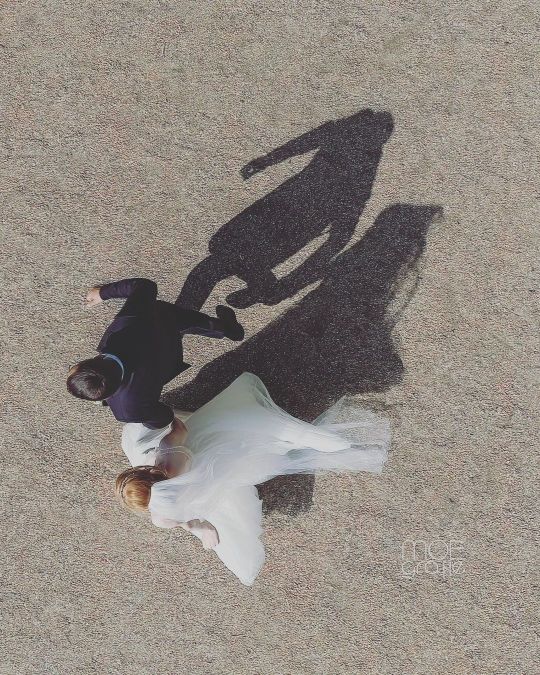
❣️🏃🏻♂️👰♀️🤵🏻♂️ Thx Lidwina and Justin🥰 #wedding #weddingart #weddingphotography #weddingphotographer #wedding20xx #weddingphotographerberlin #hochzeitsfotografberlin #hochzeitsfotograf #hochzeitswahn #weddchecker #weddinginspiration #hochzeitsfotografie #instawedding #hochzeit #dreamweddingshots #moegrafie #moeweddingart #fineartwedding #weddingday #weddingphoto #loveofmylife #instahochzeit #weddingcouple #bride #bestweddingshots #weddingphotoinspiration #weddingdrone #modernweddingphotography #pricewinningweddingphotography #weddingartgallery (hier: Schloss Ludwigslust) https://www.instagram.com/p/Cgo41zEqJO_/?igshid=NGJjMDIxMWI=
#wedding#weddingart#weddingphotography#weddingphotographer#wedding20xx#weddingphotographerberlin#hochzeitsfotografberlin#hochzeitsfotograf#hochzeitswahn#weddchecker#weddinginspiration#hochzeitsfotografie#instawedding#hochzeit#dreamweddingshots#moegrafie#moeweddingart#fineartwedding#weddingday#weddingphoto#loveofmylife#instahochzeit#weddingcouple#bride#bestweddingshots#weddingphotoinspiration#weddingdrone#modernweddingphotography#pricewinningweddingphotography#weddingartgallery
0 notes
Text
Deutschland- & Europareise 2022
APRIL 2022
20.4. Mi Hamburg, Rathausmarkt, Hafencity, Philharmonie, Planten un Blomen
21. 4. Do München Marienplatz, Residenz, Hofgarten
23. 4. Sa Leipzig, Zentrum und Völkerschlachtdenkmal
24. 4. So Ludwigslust, Schloss und Schlosspark
26.4. Di Stade bei Hamburg
28. 4. Do Heidelberg, Schloss und Hauptstraße
29.4. Fr Dresden, Prager Strasse und Umgebung
MAI 2022
1.5. So Dresden, Brühlsche Terrasse, vor allem Zwinger
2.5. Mo Görlitz, tatsächlich so schön wie vielfach gerühmt
4.5. Mi Oberhausen Centro, wollte mir Ruhrgebiet und sein Verkehrssystem ansehen. Oberhausen hat mir gereicht und ich bin zurück nachhause und neue Sport-Laufschuhe kaufen.
Die Centro-Shoppingmall ist tatsächlich sehr groß mit überdurchschnittlich großen Läden und Gängen. Innen ganz ansehnlich und gediegen, von außen sieht es aus wie eine Fabrik
5.5 Do Schwerin, Zentrum und Schloss. Das merklich herausgeputzte Stadtzentrum und der große Schlosspark haben mir gleichermaßen sehr gut gefallen.
7.5. Sa Tübingen und Stuttgart Stadtbibliothek
Tübingen ist eine schöne, altertümliche Märchenstadt, die hypermoderne Stadtbibliothek in Stuttgart am genauso modernen Mailänder Platz ist ein schönes Leseparadies.
8.5. So Neubrandenburg und Neustrelitz
10. 5. Di München, Schloss Nymphenburg
11.5. Mi Weimar
13.5. Fr Prag
15.5. So Rothenburg ob der Tauber
16.5. Mo Quedlinburg
18.5. Mi Chemnitz und Halle/Saale
19.5. Do Pirna und Videobahnfahrt durch Sächsische Schweiz an der Elbe zwischen Pirna und Schöna
21.5 Sa Mainz, Zentrum, Markt, Dom, Rheinufer, zufällig mit Rheinland-Pfalz-Tag im gesamten Stadtzentrum,
22.5. So Erfurt: Anger, Wenigemarkt, Krämerbrücke, Fischmarkt, Domplatz, malerisch schön
24.5. Di Jena, wirkt auf mich etwas nichtssagend und unförmig zusammengewürfelt, vielleicht wegen Übergewicht Technologiestadt?
26.5. Do Rostock, mit sachkundiger Stadtführung durch sturmerprobte Stadtführer
27.5. Fr Wuppertal, Zentrum und Schwebebahn. Interessanteste und schönste mir bekannte Bahnhofsumgebung in Deutschland mit direkter, offener Verbindung zu ähnlich attraktiver Fußgängerzone, 2010-18 neu gebaut
29.5. So Nürnberg, Reichsparteitagsgelände und Altstadt
31.5. Di Schloss und Schlosspark Ludwigsburg
3.6. Fr Amsterdam und Utrecht
Utrecht fand ich auf seine Art noch schöner als das weltstädtische Amsterdam (mit Grachtenfahrt, quietschbunter Fußgängerzone und großem Markt) mit seiner reizvollen Mischung aus hypermoderner Bahnhofsgegend und wunderschöner Grachten-Altstadt
5.6.. So Lüneburg, schönes, aber auch etwas langweiliges Bildungsbürger-Städtchen
6.6. PfMo Kassel Wilhelmshöhe, riesiger, grandioser Landschaftspark mit Schloss und Wasserspiel
8.6. Mi Lutherstadt Wittenberg: schönes historisches Flair, das mich leicht an Bamberg erinnerte
danach nochmal kurz in Leipzig, dessen Bahnhofsgegend mittlerweile ��berbaut und nervig wirkt mit viel zu vielen Menschen in viel zu engen Gassen und Straßen
9.6. Do nach Stippvisite in IC-Endstation Warnemünde ---> Güstrow: schöner, aber noch entwicklungsbedürftiger, ostdeutscher kleinstädtischer Provinzcharme, das Schloss leider eine Baustelle, offen war nur der leicht verdorrte Schlossgarten
11.6. Sa Limburg (Lahn), sehr gut und historisch ursprünglich erhaltene Altstadt und damit eine der schönsten Altstädte kleinerer deutscher Städte (neben Metropolen wie München, Dresden, Frankfurt)
13.6. Mo Fulda, Mischung aus in die Jahre gekommener, leicht vergilbter 50/60er Jahre westdeutscher Neubau-Aura und interessanter Dom- und Schlossgegend mit schönem Schlosspark
14.6. Di Goslar, opulente Harz-Fachwerkstadt
16.6. Videobahnfahrt Frankenwaldbahn von Saalfeld nach Bamberg und Besichtigung Bamberg
Der Frankenwald wirkte viel weniger eindrucksvoll als noch vor zehn Jahren, als dort noch der ICE majestätisch langsam durch den dichten, dunklen Wald fuhr. Mittlerweile rauscht der schnellere Regionalexpress durch den vielerorts abgeholzten Frankenwald; Bamberg mit Wasser und Menschen gleichermaßen sprudelnd und historisch altertümlich wie eh und je.
17.6. Kassel, Herkules, grandiose Aussicht auf die Erde und Kassel wie aus einer Raumstation
19.6. Wernigerode, Altstadt, Markt, Rathaus und Schloss (letzteres via Bimmelbahn), zugleich Bahnhof der Harzer Schmalspurbahn
22.6. Brüssel, hat mir trotz einiger schöner interessanter repräsentativer Plätze insgesamt nicht gefallen. Keine Stadt für Menschen, sondern für Autofahrer.
24.6. Stralsund, hübsch, hübsch, inklusive der weiten Ostsee rüber nach Rügen
25. 6. Sa. Wolfenbüttel, idyllisches Fachwerkstädtchen mit viel Wasser und Parks, sowie dem repräsentativen Lessingplatz und Schlossplatz mit etlichen historischen Gebäuden wie dem Schloss, Zeughaus und der Herzog-August-Bibliothek. Bekannt als Lessingstadt vor allem wegen des Wirkens von Lessing (und Leibniz)
27.6. Mo Greifswald
Der Elan für die Besichtigung Greifswalds war durch starke Hitze etwas angegriffen. Greifswald hat sich nichtsdestotrotz auch gut herausgemacht, wobei es vielleicht noch etwas kleinstädtischer als das weltstädtischere, maritime Stralsund mit seiner Ostseelage wirkt.
28.6. Di Bremen, Zentrum und Schnoorviertel
Bremen ist sehr schön mit seiner Mischung aus Stadtzentrum und sehr schönem Park-Wall-Naturgürtel, wie auch Greifswald einen hat. Das Schnoorviertel ist ein sehr verwinkeltes historisches Schickimicki-Kitsch-Viertel ähnlich wie das Holländische Viertel in Potsdam oder Stade, aber nichtsdestotrotz auch sehr schön.
30.06. Koblenz: Innenstadt, Rheinpromenade und Deutsches Eck
Ziemlicher Kontrast aus schöner Wassergegend mit imposantem Deutschen Eck und bescheiden schöner Innenstadt. Zuerst wollte ich die Stadt schon als eine der hässlichsten Städte Deutschlands brandmarken, auf dem Weg zurück kam ich dann aber doch noch durch einige ganz ansehnliche Fußgängerzonen. In der Gegend ab Bahnhof Stadtmitte herrscht außer einem neuen Zentralplatz städtebaulich trister westdeutscher Brutalismus vor.
Sa 02.07: Luxemburg und Trier
Luxemburg hat eine ähnlich reizvolle Verbindung von Verkehrs- und Architekturmoderne mit historisch gewachsener Altstadtarchitektur wie Utrecht.
In Trier bilden die Porta Nigra, Fußgängerzone und Markt ein schönes, dicht bevölkertes innerstädtisches Ensemble.
Mo 4.7. Wiesbaden, überdurchschnittlich mondäne Architektur und ein Venedig weitverzweigter Fussgängerzonen mit schönem Marktplatz mit Rathaus, Stadtschloss = Hessischer Landtag und imposanter Kirche
Di 5.7. Frankfurt/Main: interessante Mischung aus Moderne, z.T. Hypermoderne und opulenter Altstadt, letzteres insbesondere am Römerberg und dem Ensemble um das berühmte Rathaus herum. Schön modern neben den Wolkenkratzern im Bankenviertel Mainhattan auch die lange Einkaufsstrasse Zeil. Insgesamt macht die Stadt einen recht chaotischen Eindruck. Die Kaiserstraße ab Hauptbahnhof wirkt gar nicht kaiserlich, sondern ist die heruntergekommenste und chaotischste mir bekannte Bahnhofsgegend mit vielen Pennern, Obdachlosen, Junkies, Bettlern usw.
Do 7.7. Karlsruhe und Speyer
In Karlsruhe war ich vor allem wegen dem riesigen Schloss mit Schlosspark, das ich vor zehn Jahren aus Zeitgründen nur kurz von vorn gesehen hatte. Schloss und Schlosspark Karlsruhe sind in ihren Dimensionen vergleichbar mit Sanssouci, mit gestaltetem Garten davor und großem, ähnlich schönem Schlosspark dahinter. Links neben dem Schloss habe ich gleich noch das direkt daneben gelegene Bundesverfassungsgericht besichtigt.
Danach ging es noch nach Speyer mit seinem berühmten und wirklich imposanten Dom, an dessen etwas abseits gelegenem Direktweg auch die Kohlgrabstätte liegt. Der etwas abseits gelegene Direktweg war von Vorteil auch insofern, als er einen guten Eindruck vom leicht französisch angehauchten Häuserstil mit vielen Beige- und Pastellfarben vermittelte, wie ich es schon in Strasbourg gesehen habe. Der Rückweg ab Dom zum Bahnhof ging durch die belebte Fußgängerzone - auch interessant, das Übliche mit vielen Cafés, Geschäften, interessanter Architektur usw.
Sa 9.7. Innsbruck: Die Innenstadt ist ähnlich repräsentativ schön und dicht besucht wie Salzburg, zumal auch Innsbruck wie Salzburg (und Wien) eine höfische Burg sowie eine verwinkelte Altstadt hat und noch beeindruckender von hohen Bergen umgeben ist als Salzburg. Schon die Bahnstrecke von München nach Innsbruck ist in der Hinsicht ab Kufstein sehr reizvoll, es folgt ein hochaufragender Berg auf den nächsten.
Mo 11.7. Ulm: Der Besuch war kurz und schmerzlos: Die Innenstadt besteht aus dem großen Münster und einem sehr schönen, opulent farbigen Rathaus, umgeben von einer breitflächigen, modernen und wie üblich quirligen Fußgängerzone, mit der Donau an der Seite. Etwas beeinträchtigt wurde der ansehnliche Gesamteindruck nur dadurch, dass die Bahnhofsgegend derzeit eine einzige Baustelle ist.
Mi 13.7. Kopenhagen - war ganz interessant mal gesehen zu haben - die betuliche dänische Mentalität und Ästhetik sind aber nicht so meine. Abseits der Sehenswürdigkeiten besteht Kopenhagen aus riesigen Häusern, aus denen nicht ersichtlich wird, was drin steckt. Morgens fahren Massen radfahrender Zombies durch die Stadt. Am beeindruckendsten fand ich noch die Bahnfahrt über die lange Beltbrücke durchs Meer hindurch. Kopenhagen verkörpert eigentlich ganz gut die Kleinheit Dänemarks, es wirkt hinter der Bahnhofsgegend und der dichtbevölkerten Einkaufsstraße Stroeget wie eine zusammengewürfelte Kleinstadt.
0 notes
Photo

#OnThisDay År 1786, fødsel af kong Christian VIII af Danmark. også kendt som Christian Frederick I af Norge, var kongen af Norge fra februar til oktober 1814 (efterfølger Frederik VI og før Charles XIII) og konge af Danmark fra 1839 til 1848 (efterfølger Frederick VI og forud for Frederik VII. .christian blev født på Christiansborg Slot i København. Han var den ældste søn af arvelig prins Frederik af Danmark og Norge og hertuginde Sophia Frederica af Mecklenburg-Schwerin. .hans bedsteforældre var kong Frederik V af Danmark-Norge og hans anden kone, hertuginde Juliana Maria af Brunswick-Wolfenbüttel. Christian giftede sig først med sin fætter hertuginde Charlotte Frederica af Mecklenburg-Schwerin i Ludwigslust den 21. juni 1806 ..charlotte Frederica var datter af Friedrich Franz I, storhertug af Mecklenburg-Schwerin og prinsesse Louise af Saxe-Gotha-Altenburg (1756-1808). Hans førstefødte søn var Christian Frederik, som blev født og døde på Schloss Plön den 8. april 1807. Hans anden søn blev Frederik VII af Danmark. .ægteskabet blev opløst ved skilsmisse i 1810 efter Charlotte Frederica blev anklaget for utroskab.christian giftede sig med sin anden kone, prinsesse Caroline Amalie af Slesvig-Holsten-Sonderburg-Augustenburg (datter af Louise Augusta af Danmark, den eneste søster til Frederik VI) på Augustenborg Slot den 22. maj 1815 ..parret var barnløse og levede i komparativ pensionering som ledere i det litterære og videnskabelige samfund i København, indtil Christian besteg Danmarks trone. Kong Christian giftede sig først med sin fætter hertuginde Charlotte Frederica af Mecklenburg-Schwerin i Ludwigslust den 21. juni 1806. Ægteskabet blev opløst ved skilsmisse i 1810, efter at Charlotte Frederica blev anklaget for utroskab. Kong Christian giftede sig med sin anden kone, prinsesse Caroline Amalie af Slesvig-Holsten-Sonderburg-Augustenburg (datter af Louise Augusta af Danmark, den eneste søster til Frederik VI) på Augustenborg Slot den 22. maj 1815. Kong Christian døde af blodforgiftning i Amalienborg Slot i 1848 og blev begravet i Roskilde Domkirke. #DanishRoyalHistory #detdanskekongehus #detkongelige #KongChristianVIII #KingChristianVIII https://www.instagram.com/p/CT9PsHGvScV/?utm_medium=tumblr
1 note
·
View note
Photo

Schlossstraße in Ludwigslust - Blick zum Lindencenter #ludwigslust #schlossstrasse #luftbild #aerialphotography #dronephotography #dronestagram #mecklenburg #schloss #mavicpro #djimavicpro #mecklenburgvorpommern #germany (hier: Ludwigslust, Germany)
#dronestagram#germany#aerialphotography#luftbild#mecklenburg#djimavicpro#dronephotography#schlossstrasse#mavicpro#schloss#ludwigslust#mecklenburgvorpommern
4 notes
·
View notes